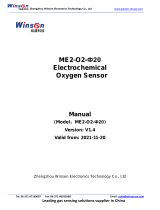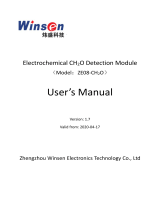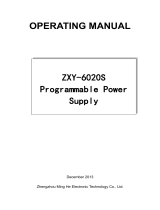Page is loading ...

Zhengzhou Winsen Electronics Technology Co., Ltd. www.winsen-sensor.com
Tel: 86-371-67169097/67169670 Fax: 86-371-60932988 Email: [email protected]om
Leading sensing solution supplier in China!
Photoionization PID Sensor
User’s Manual V2.0
(Model:4R-PID)
Valid from: 2021-05
Zhengzhou Winsen Electronics Technology Co., Ltd

Zhengzhou Winsen Electronics Technology Co., Ltd. www.winsen-sensor.com
Tel: 86-371-67169097/67169670 Fax: 86-371-60932988 Email: [email protected]om
Leading sensing solution supplier in China!
Statement
This manual copyright belongs to Zhengzhou Winsen Electronics Technology Co., LTD. Without the
written permission, any part of this manual shall not be copied, translated, stored in database or
retrieval system, also can’t spread through electronic, copying, record ways.
Thanks for purchasing our product. In order to let customers use it better and reduce the faults
caused by misuse, please read the manual carefully and operate it correctly in accordance with the
instructions. If users disobey the terms or remove, disassemble, change the components inside of
the sensor, we shall not be responsible for the loss.
The specific such as color, appearance, sizes …etc., please in kind prevail.
We are devoting ourselves to products development and technical innovation, so we reserve the
right to improve the products without notice. Please confirm it is the valid version before using this
manual. At the same time, users’ comments on optimized using way are welcome.
Please keep the manual properly, in order to get help if you have questions during the usage in the
future.
Zhengzhou Winsen Electronics Technology CO., LTD

Zhengzhou Winsen Electronics Technology Co., Ltd. www.winsen-sensor.com
Tel: 86-371-67169097/67169670 Fax: 86-371-60932988 Email: [email protected]om
Leading sensing solution supplier in China!
Photoionization PID Sensor 4R-PID
Product Introduction
4R-PID is a high-performance photoionization PID sensor. It has
the characteristics of high sensitivity, wide detection range and
wide spectrum. It can detect thousands of volatile organic
compounds (VOCs) and some inorganic vapors in different
application fields. The detection range starts from 1ppb and is
up to 10000 ppm, with extremely fast response speed and high
resolution. It can be used in kinds of portable and fixed
instruments and various of analytical instruments.
Features
High sensitivity; Wide detection range; Fast response time; Reliable stability; Long service
life; World leading technology.
Main Application
Fig2.Dimension (unit: mm)
Pins definition
PIN1. Power supply (3.2~5.5V DC)
Pin2. Signal output
Pin3. GND
Emergency Response
Industrial Hygiene
Personal Safety
Detection of VOCs
Monitoring of Environmental Quality
Oil and Petrochemical Safety
Soil Pollution and Management
Fig1. Sensor picture

Zhengzhou Winsen Electronics Technology Co., Ltd. www.winsen-sensor.com
Tel: 86-371-67169097/67169670 Fax: 86-371-60932988 Email: [email protected]om
Leading sensing solution supplier in China!
Technical Parameters
Signal Output
Fig3. Typical linear output curve(100ppm) Fig4. Typical linear output curve(6000ppm)
Detection Range
(ppm)
0~10 ppm
0~40ppm
0~100ppm
0~6000ppm
0~10000 ppm
Resolution
1ppb
10ppb
25ppb
500ppb
2ppm
Sensitivity
(mv/ppm)
>40
>10
>5
>0.1
>0.1
Target Gas
VOC,Energy≤10.6eV Volatile Gases
Working Voltage
3.2~5.5 V
Zero Voltage
U0>20 mV
Output Voltage
0.02~2.0V (3.3 V max)
Response Time
(T90)
≤5 S
Accuracy
≤±2% (No Condensation)
Humidity
0~99% (No Condensation)
Working Pressure
800~1200 mbar
Storage Tem
0~25℃
Working Tem
-20~50 ℃
Lifespan
3 years (lamp and electrode not included)
Warranty
12 Months (lamp and electrode not included)
Output
signal (%)
Gas concentration(ppm)

Zhengzhou Winsen Electronics Technology Co., Ltd. www.winsen-sensor.com
Tel: 86-371-67169097/67169670 Fax: 86-371-60932988 Email: [email protected]om
Leading sensing solution supplier in China!
Temperature influence
The normal operating temperature of the sensor ranges from -20ºC to 50ºC. The sensor works up
to -30 ° C without damage to the sensor, however the performance of the sensor is not guaranteed
at extreme temperatures. The change of ambient temperature has little influence on the
performance of the sensor. The temperature correlation curve is shown in the following figure.
Fig5. Temperature curve
Humidity influence
Fig5. Humidity curve
Gas response factor
The ratio of the sensitivity of isobutylene to that of the target gas is called the response factor
(RF). For example, the sensitivity of the sensor is 1mV/ PPM for isobutene and 2mV/PPM for
benzene, which means that the RF of benzene is equal to 0.5, and the response factor is also
different due to the different PID sensor structure design. When using the response factor table,
note the following:

Zhengzhou Winsen Electronics Technology Co., Ltd. www.winsen-sensor.com
Tel: 86-371-67169097/67169670 Fax: 86-371-60932988 Email: [email protected]om
Leading sensing solution supplier in China!
●With isobutene as the reference gas and dry air as the equilibrium gas, the response factors of
each gas measured under laboratory conditions;
●Depending on the measurement conditions (sample temperature and humidity, background gas,
and lamp conditions), the actual value of the response factor in the customer's application may
vary;
●Approximate calibration can be performed using response factors when calibration with actual
gases is not feasible
Calibration and drifting
The response of the sensor to the gas may vary over time, and the main reason for this deviation is
contamination of the uv lamp window. If the sensor is applied to ambient air containing ionization
of heavy compounds or particles, the lamp window will be susceptible to contamination. The
window pollution rate is related to the sample gas state, that is, the severity of pollution by
chemical substances and particles. The pollution of the lamp window will cause part of the
ultraviolet ray to be blocked, thus reducing the sensitivity of the PID sensor. In this case, more
frequent calibration and regular cleaning of light Windows are required.
Most volatile organic compounds (such as isobutene, benzene, etc.) do not contaminate the
window and the drift is very small. However, some compounds, such as silicone, can quickly deposit
and adhere to the light window. In this case, drift may reach 10-20% within 8 hours. In general, if
the sensor is used in a relatively clean environment, the recalibration cycle can be slightly longer, so
the recalibration cycle can be determined depending on the desired environment and accuracy,
ranging from once a month to once every six months.
Cautions:
●For the first time, the sensor should be preheated for at least half an hour.
●When the calibration is carried out, the operation shall be proceeded after the sensor is
completely stable, and the zero point calibration shall be carried out in dry clean air;
●Isobutene gas with a range of about 50% is recommended to be used as the calibration gas.
●Hot plug and insert for the sensor with power on is prohibited.
●It is forbidden to weld the sensor pins, and the pin-sockets are used to connect, and the pin-
sockets are allowed to be welded;
●The sensor is not subjected to excessive impact and vibration;
●Do not use the sensor in systems involving personal safety;
●Do not install the sensor in a strong air convection environment, to avoid pressure changes back
and forth, resulting in value fluctuation or sensor damage;
●Do not use or store in an environment beyond the range of the sensor for a long time;
/






